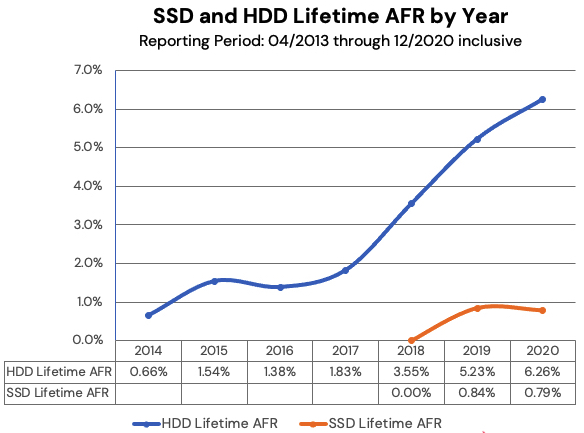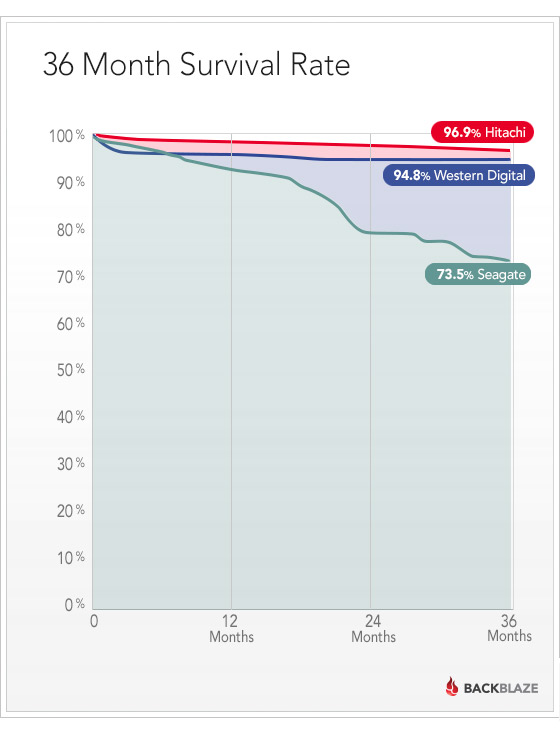

29,844 - The number of hard drives that were installed in 2017.This means 25,528 drives have either failed or been removed from service due for some other reason - typically migration. Currently there are 91,305 drives (data drives) in operation. 116,833 - The number of hard drives for which we have data from April 2013 through the end of December 2017.


To save you countless hours of looking, we’ve culled through the data to uncover the following tidbits regarding our ever changing hard drive farm. The HGST/Hitachi 4 TB models delivered sub 1.0% failure rates for each of the three years.That’s impressive, but with only 45 drives in use for each model, not statistically useful. The Toshiba 5 TB model and the HGST 8 TB model had zero failures over the last year.While the remaining 180 WDC 3 TB drives are performing very well, decreasing the data set that dramatically makes trend analysis suspect. While it looks like the failure rates for the 3 TB WDC drives have also decreased, you’ll notice that we migrated out nearly 1,000 of these WDC drives in 2017.The failure rates for both of the 6 TB models, Seagate and WDC, have decreased over the years while the number of drives has stayed fairly consistent from year to year.In looking at the results the following observations can be made: The failure rate for each year is calculated for just that year. The disks of with a large number in use and that have dropout a percentages above two percent, are the Seagate ST12000NM0007 with a failure rate of 2.01 percent, the Western Digital WD60EFRX, with a failure rate of 3.66 percent and the Seagate ST4000DM000, with a failure rate of 2.89 percent. As with the quarterly results above, Backblaze have removed any non-production drives and any models that had fewer than 45 drives. Of that number, there were 1,935 boot drives and 91,305 data drivesīelow are the lifetime hard drive failure statistics for the hard drive models that were operational at the end of Q4 2017. At the end of 2017 they had 93,240 spinning hard drives. In 2020, the failure rate was 0.93% and in 2021 it was 1.10%.Backblaze has recorded and saved daily hard drive statistics from the drives in their data centers and released the statistics for the year 2017. This increase is due to the age of the drives, as all hardware becomes more likely to fail over time. The yearly failure rate for hard drives has risen in the past three years, reaching 1.37% in 2022. Additionally, these drives had only been in use for a little over 22,000 days and were mainly used as backup drives to replace failed drives. It had no failures recorded in 2022, but it's important to note that there were only 79 of these drives in use. Seagate's 8TB hard drive, the Exos ST8000NM000A, was the standout performer in the report. The HGST Ultrastar He8 8TB and Seagate Exos X14 14TB had the highest failure rates at 5.27% and 5.70%, respectively, but it's important to consider the smaller sample size for these models. This is due to the aging of the drives, which become more prone to failure over time. The annualized failure rate for hard drives has increased in recent years, with the rate for 2022 reaching 1.37%. However, it's important to note that Backblaze only had 79 of these drives in use. The company analyzed 230,921 hard drives and found that Seagate's Exos 8TB (ST8000NM000A) had no failures in 2022. The report provides information on the reliability of hard drives, which are still relevant for secondary storage despite the popularity of SSDs. Backblaze, a cloud storage and data backup company, has published its annual report on hard drive failures for 2022.


 0 kommentar(er)
0 kommentar(er)
